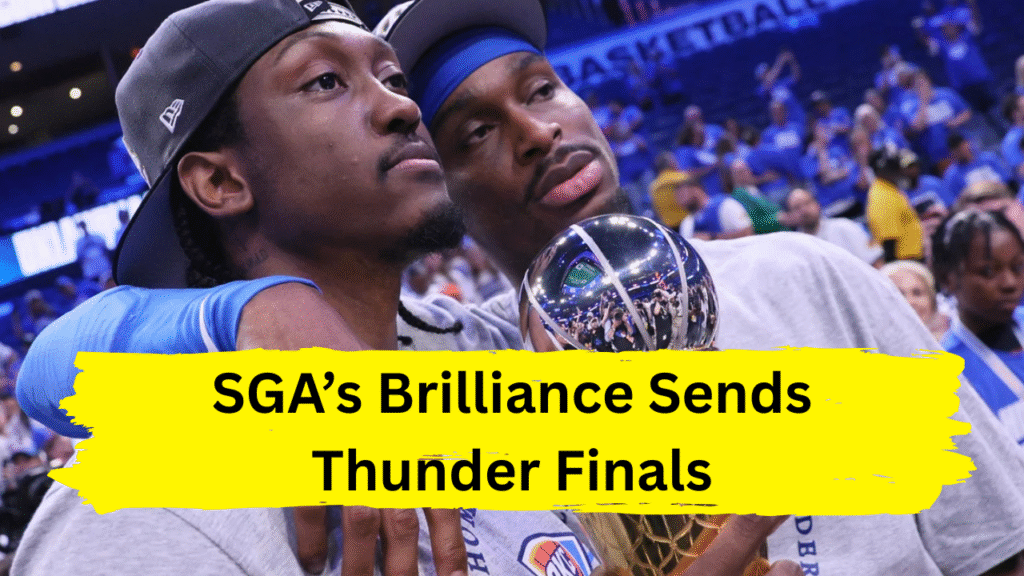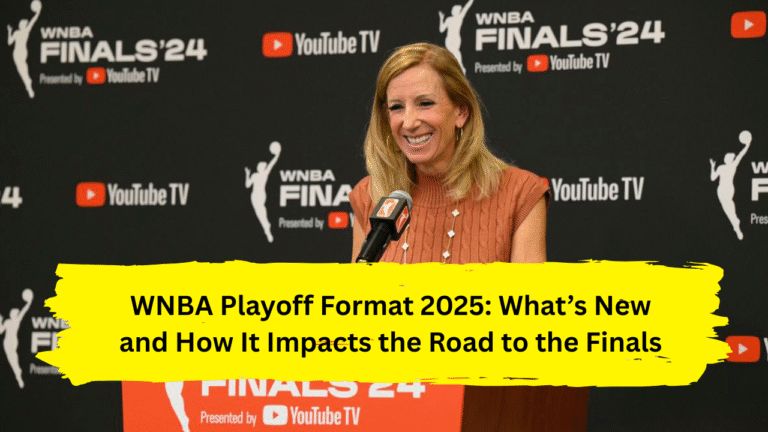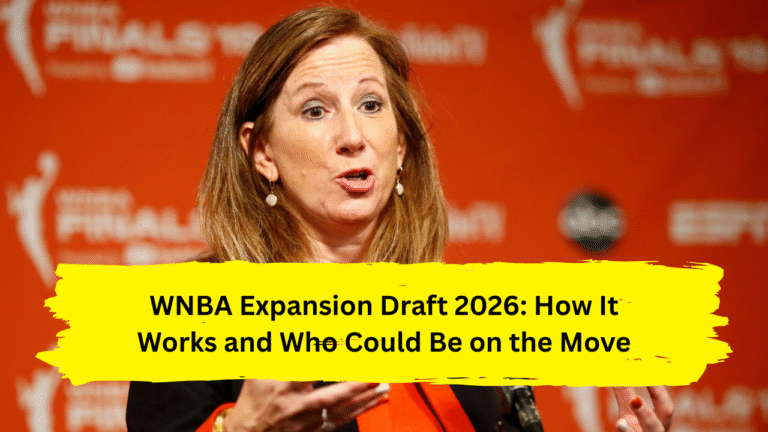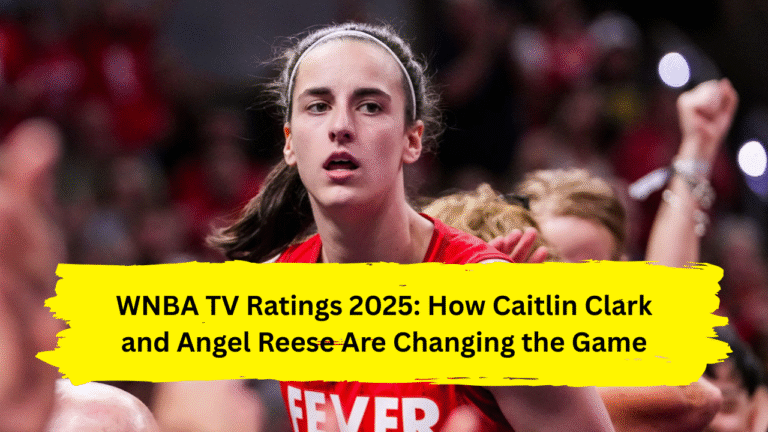
The roar inside Paycom Center began as a murmur—a low-frequency hum of anticipation crackling beneath the surface. By the time Shai Gilgeous-Alexander drained his first pull-up jumper just 90 seconds into Game 5, it erupted into a primal cascade of sound, washing over the Minnesota Timberwolves in waves they could not withstand. What followed was less a basketball game than a coronation: a 124-94 demolition so comprehensive it announced the Oklahoma City Thunder’s arrival on the NBA’s grandest stage with the subtlety of a thunderclap . Behind SGA’s 34-point masterpiece and a defensive stranglehold that broke the Wolves’ spirit before halftime, the Thunder clinched their first NBA Finals berth since 2012, transforming years of meticulous rebuilding into a 30-point exclamation point .
The Blowout: A First-Quarter Execution
From the opening tip, Oklahoma City played with the ferocious urgency of a team that understood history’s weight. The Thunder’s 11-3 opening run wasn’t merely scoring; it was a tactical dissection. Gilgeous-Alexander, freshly crowned league MVP, attacked the paint with surgical precision, either finishing through contact or kicking out to shooters when Minnesota’s defense collapsed. The Timberwolves, meanwhile, unraveled. They missed 17 of their first 20 shots, clanking open threes and coughing up turnovers against OKC’s swarming perimeter defense. By the end of a nightmarish first quarter, the scoreboard read 26-9—Minnesota’s lowest-scoring quarter all season—sealed by rookie Cason Wallace’s buzzer-beating three-pointer off an SGA assist . The game, for all intents, was over.
SGA: The Architect of Dominance
Gilgeous-Alexander’s stat line—34 points, 8 assists, 7 rebounds—only hints at his gravitational influence. He scored or assisted on 32 first-half points, single-handedly matching Minnesota’s entire output through two quarters (32 points) . Every Wolves rally died at his feet: a steal leading to a transition dunk, a step-back three over a helpless defender, or a drive drawing three defenders before finding Chet Holmgren (22 points, 3 blocks) for an uncontested dunk. His performance earned him the Western Conference Finals MVP trophy, a unanimous decision cementing a season where he collected virtually every individual honor—scoring champion, All-NBA First Team, league MVP—while keeping his eyes fixed on the ultimate prize . “This isn’t our goal,” SGA stated postgame, the trophy momentarily raised but not cherished. “We have one more round” .
The Thunder’s Evolution: From Rebuild to Juggernaut
The magnitude of this moment resonates deeper when contextualized by OKC’s journey. Just four years ago, this franchise languished near the league’s bottom after the emotional scars of Kevin Durant’s 2016 departure and subsequent rebuild . General Manager Sam Presti’s blueprint—patience, elite drafting, and a culture prioritizing defensive connectivity—culminated in a league-best 68-14 regular season record. This young core, the NBA’s youngest to start the season, mirrors the franchise’s first Finals team in 2012 featuring Durant, Westbrook, and Harden. Yet this iteration—SGA, Holmgren, and Jalen Williams (19 points, 8 rebounds in Game 5)—boasts something their predecessors lacked: elite, switchable defense as its bedrock identity . Coach Mark Daigneault distilled their maturity: “The focus through the distraction of a close-out game… they were laser-focused. The mental toughness was great” .
Defense: The Engine of Destruction
While SGA’s brilliance headlines, OKC’s historically stifling defense engineered this rout. The Thunder forced 21 Timberwolves turnovers, converting them into 33 points . By halftime, Minnesota had more turnovers (14) than made field goals (12) . Lu Dort and Alex Caruso harassed Anthony Edwards into rushed jumpers and driving lanes that evaporated into crowds. Holmgren’s rim protection (3 blocks) erased attempts at interior answers. Edwards, visibly gassed by the second half, finished with 19 points on inefficient shooting—his third sub-40% game of the series . “They clogged the paint… every time I drive there’s like four people,” Edwards conceded after Game 1, a frustration that only intensified by Game 5’s closure . This defensive versatility, blending length, IQ, and relentless ball pressure, held Minnesota to a feeble 41.2% shooting for the game .
Minnesota’s Collapse and Crossroads
For the Timberwolves, a second consecutive conference finals exit raises urgent questions. Anthony Edwards, despite flashes of brilliance (like his 40-point Game 3), again faded under exhaustion. Analysts pointedly noted his need to reach “championship shape” to endure the grueling two-month playoff grind . The offseason looms large with key free agents—Julius Randle (24 points in Game 5, player option), Naz Reid, and Nickeil Alexander-Walker—requiring costly decisions under new ownership . The gap between Minnesota and Oklahoma City, starkly evident in this series, extends beyond talent; it’s systemic, rooted in sustainable roster construction and youthful depth that wears opponents into submission .
The Finals Await
Oklahoma City now awaits the winner of the Pacers-Knicks series, holding home-court advantage when the Finals begin June 5 . Their depth—from Caruso’s elite secondary playmaking to Cason Wallace’s timely shooting—and defensive adaptability make them overwhelming favorites against either potential opponent . Yet the Thunder’s mindset remains fixed beyond the conference trophy. As confetti rained down Wednesday night, Gilgeous-Alexander’s demeanor was less celebration than acknowledgment. This victory, historic as it is for a franchise and city waiting 13 years to return, is merely the threshold. The mission, meticulously built through years of patience and punctuated by a 30-point masterpiece, now demands four more wins . The Thunder’s roar echoes not just in Oklahoma, but across the league: a young dynasty has arrived, and its final act awaits center stage.




